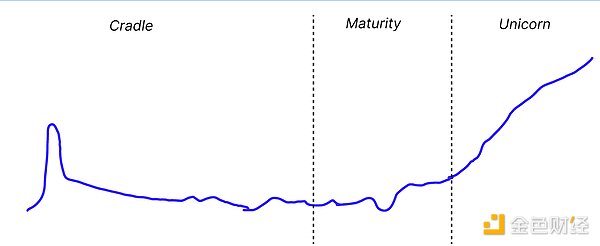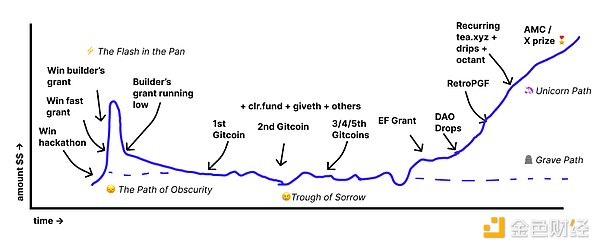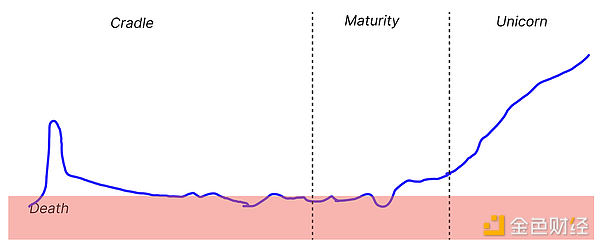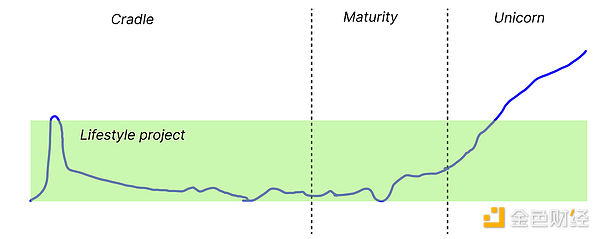Written by:Carl Cervone, Kevin Owocki
Compilation: Innocence
Editor's Note: Open source project Carl Cervone, a member of the analysis product Open Source Observer team, and Kevin Owocki, co-founder of Gitcoin, jointly wrote an article to break down the financing cycle of Ethereum ecological public goods, as well as the problems and opportunities that exist in each cycle. This article provides a basic framework for cyclical research on public goods, and the opportunities mentioned in it have great reference value as construction directions.
TLDR
This article discusses the end-to-end financing life cycle of Ethereum public goods;
We believe that solving these problems can Creating a sustainable competitive advantage for the cryptocurrency ecosystem;
We outline the life cycle of public goods financing:
The cradle phase focuses on building and obtaining initial funding;
The maturity stage includes community building and surviving the "sad valley";
The unicorn stage is about achieving significant impact and obtaining retroactive funding.

Private goods financing project life cycle
There is a famous chart showing the life cycle of a start-up: from the first Being reported by TechCrunch, it gradually lost its novelty, then went into a long-term "sad trough", and finally crossed the chasm and was sold for billions of dollars.

Such startups are typically funded by venture capital firms. Most of them die in the trough because they run out of money before finding product-market fit.
The financing infrastructure for startups is already pretty well established: they get some initial capital from venture capital to build a product around their idea; if they enter the growth phase , they get more venture capital (and revenue); ultimately, if all goes well, when the company has a liquidity event, everyone gets a huge return on the money they put in.
In addition, there is a value chain composed of different funders who specialize in providing funds for start-ups of different types and stages. Early stage investors are often very different from later stage investors. Early-stage investors mostly bet on people, so they need domain expertise and networking to find good deals. Late-stage investors are more numbers-oriented, so they will pay close attention to a company's metrics and macro picture. Investors in this space can provide valuable resources, including education, recruiting, mentorship, and more.
Public Goods Financing Project Life Cycle
Let’s consider the Ethereum public goods ecosystem A similar funding lifecycle diagram might look like, ideally funding teams before, during and after they have impact.

To accelerate innovation, every viable project should be funded during the "cradle to unicorn" stage of the public goods organization's life cycle.
Additionally, ongoing funding, validation, and other resources are needed to help projects get through the “sad trough” from initial construction to unicorn status. Not all projects are successful. In fact, most projects don't. Nor should we be ashamed if the project ultimately dies and the team moves on (and we should especially encourage making the lessons learned by these teams public so that future teams don’t make the same mistakes).
1. Cradle: potential financing stage

In the initial stage (early to mid-term in the picture above), funds are needed to reduce the upfront costs of starting a business. People are afraid of quitting their jobs, and applying for many financial aid programs is difficult and time-consuming.
However, funding cannot be provided without review. To truly help builders, builders also need to validate what creates value for how many people. Along with getting funding, you also need to verify that your work is important.
Bounties and hackathons are great ways to seed ideas, but they are unpredictable and incentivize teams to constantly switch projects/jump ecosystems. There should be a better path from winning a few small hackathons to landing a large grant, with maybe a few mid-sized quick grants in between. This will help more projects get off the ground and provide an easier path for proven builders to quit their jobs and pursue the job full-time. This also helps allow builders to focus on specific ecosystems rather than jumping from grant to grant.
In the cradle stage, projects should focus on what matters most: construction. They should build in public areas whenever possible. Anything that simplifies their life + allows them to focus on building/learning, whether it's finding insurance or hiring a good smart contract auditor, is worth it. Ideally, they shouldn't spend too much time worrying about where their next money will come from.
In our diagram, this phase begins with winning a hackathon and ends with receiving a small grant from the Ethereum Foundation. They haven't made any real impact yet, but they've proven worthy of a lot of potential funding to build something.
2. Maturity: community financing stage

Now this project has some funds, but it is running very unsatisfactory. It's building and trying different things, but often no one really cares yet.
"Sad valley" is like a bear market for a project. It's even harder when your "sad trough" coincides with a financial bear market.
In order to get through the "sad valley" and grow into a full-fledged public good project, you need to build a community and start to have real demonstrable impact on these people. Influence. This is the stage where community funding mechanisms like quadratic financing and direct grants are most valuable.
While most projects won't be able to raise $100,000 this way, they should be able to secure enough funding to survive and continue to grow. These mechanisms force projects to stay close to the community and increase community awareness.
The projects that perform best on Gitcoin Grant are those that already exist and have established a reputation, rather than those that announced their existence to the world through Gitcoin. We observed this to be true for other funding platforms including clr.fund and Giveth.
The best projects mature at this stage and have a good reputation in the community for providing useful public goods.
3. Unicorn: retroactive financing stage

At some point, the project will reach an inflection point, and the impact on the ecosystem will be far-reaching More than fair compensation received. We hope this is where the large amount of retroactive funding comes into play.
Ideally, we will start to see a variety of complementary mechanisms funding these projects. ETH staking returns or ETF profits (like Van Eck) will be awarded to reputable projects. Added Optimism RetroPGF rounds, which are distributed at the discretion of a group of badge holders.
Currently, these are mostly technical mechanisms, but over time, public goods projects are expected to bring more bottom-up recurring revenue . tea.xyz and Drips v2 offer different ways to combine funds. This idea can be extended to any form of public good. The better we do at tracking impact and creating a culture that rewards upstream impact, the more likely this will become a viable recurring revenue stream for pro bono projects.
Finally, it would be exciting to have an equivalent of an X Prize or a Large Advance Market Commitment (AMC) for public goods matter.
4. Death is (sometimes) a feature, not a bug

Many projects cannot achieve sustainable development and cannot become unicorns, Rather, it died in the process of development. In some cases this is a feature rather than a bug.
When a project fails, it can provide valuable lessons for entrepreneurs, investors and the wider community. One of the main lessons is the importance of market need: many projects fail because they create a product or service that doesn't satisfy a strong need. This highlights the need for comprehensive market research and ongoing customer feedback. A failed project can also highlight the importance of timing. Even the most creative ideas need to be developed when market demand begins to emerge.
Another key lesson is the importance of flexibility and adaptability. Projects often operate in a rapidly changing environment, and the ability to make adjustments based on market changes, customer feedback, or technological advancements is crucial to the project's survival. Failure also teaches us the importance of team dynamics and leadership. A common reason for project failure is internal conflict or a lack of clear leadership and vision. Therefore, building a strong, cohesive team that is aligned with the goals of the startup is as important as the idea itself.
As a builder of the ecosystem, the most important thing is:
If the project is on the right path, don't let the project die due to lack of funds;
If the builder is on the wrong path, the path to death/reflection/revival should be hastened;
If There should be no shame in the project eventually dying and the team moving on. In particular, we should encourage making the lessons learned by these teams public so that future teams don’t make the same mistakes.
5. Not every successful project is a unicorn

Maybe "Unicorn or Death" is Wrong frame. Many projects don’t want to become unicorns. In fact, the cult of unicorns is a legacy of the venture capital model, where the entire process hinges on finding a 100x exit opportunity that returns all your money.
There needs to be a lifestyle and business model for that public good - there are opportunities to build smaller tools that provide huge value, but these tools You can never achieve exponential growth—that is, change the world or become a unicorn.
Suggestions and open questions
1. Keep making the pie bigger
< p style="text-align: left;">One similarity we can draw from venture capital/startups is that successful founders can become the next generation of investors.
We can see that contemporary unicorn companies fund the next generation of public goods projects at the cradle stage. This is already happening, with projects like 1inch and Uniswap going from being Gitcoin Grant recipients to matching pool donors and Protocol Guild donors. This should be encouraged at the social level.
We can empower the social layer by creating trusted cryptographic commitments to fund the next generation of projects. If every new project that received funding in the cradle phase issued an EAS certificate stating that they planned to use 5% of their tokens for next-generation projects, then this would create a quantifiable future for public goods funding for the next generation. promise.
Opportunities:
If the next generation of builders become unicorns, how do we attract them to make a high-integrity commitment to giving back to public goods?
How do we start a social movement and make it a trend?
How do we bring these commitments together to make credible commitments for future funding?
2.RetroPGF provides opportunities around "impact = profit"
VC drives startups to accelerate and capture as much value as possible. The thrust of public goods should be to create as much value as possible for the ecosystem.
Retrospective public goods financing provides an opportunity to promote a different value capture mechanism that merges with the "impact = profit" model.
By introducing retroactive public goods financing into the ecosystem, we can create a reliable promise of monetary returns for the public goods that have the greatest impact. Since it is easier to judge project quality retroactively than prospectively, retroactive financing is closer to "impact = profit".
But in this way, future charity funders can change the early steps in the grant life cycle. Allowing speculators to speculate on which public goods are most likely to receive retroactive returns in the future. Tools that allow users to “angel invest” in public goods early in the cycle may facilitate this development.
Another opportunity is to create proofs of impact to credibly track which projects have had the greatest impact. These large-scale proofs of impact will form a network of trust, allowing all projects to prove each other’s impact. Tools like EAS and Hypercerts can provide the basis for these proofs of impact. These tools become increasingly valuable as whale funders use them as signal detection to decide what projects to fund, and they can also serve as valuable tools for builders to understand whether they are on the right path.
Opportunities:
Incorporate Hypercerts/EAS into existing public goods funding projects
Establish a new impact proof service to help people distinguish which ones are Impactful projects
Build new forward-looking public goods financing vehicles to receive future retroactive rewards.
3. Survive the cradle stage
Create A reliable pathway through the infancy stage is the most important unsolved problem in this field.
Open questions here include:
If a builder fails to attract funding/certification, is it because there is something wrong with the ecosystem, or is it because the builder has not yet identified a problem area important enough to merit funding?
What kind of safety net do builders of public goods need in particular? Reverse thinking: How to build these safety nets so that they are not exploited?
There are definitely some services that all teams need, such as legal, back-office, recruiting, auditing, office hours, etc. Will these services become the key to independence for small teams?
Which of these services are most valuable to cradle-stage builders? What is the TAM for each new service in the cradle phase? If the TAM is large enough, we will see companies emerging to serve these niche markets. If the TAM is large enough, how can we aggregate DAOs and let them pool their resources to provide these services? How do we attract builders to provide these services?
While funding is a good start, once the developer and ecosystem are working well together, there is a need to move forward with the relationship The second step is a long-term relationship that makes developers feel comfortable and “at home”. Developers do their best work when we understand the protocol inside out and can build long-term relationships within the ecosystem. The model of hitting wherever you point is not good. How do developers transition from staged financing to recurring financing?
4. Are we just reinventing venture capital?
In some ways, the funding lifecycle of this ecosystem may begin to resemble the reinvention of venture capital.
In venture capital, funds often accumulate a pool of talented developers and other service providers who can provide founders with whatever help they need.
We should build on the successes here, but also be aware of opportunities to reinvent these ecosystem services from first principles.
Composable financing models offer builders the opportunity to have multiple different sources of funding and services (as opposed to one venture capital firm).
Retroactive public goods financing provides builders with the opportunity to focus on public goods, not just those that extract value. Value is captured by the network and fed back to the network.
The hyper-modularization of Web3 systems is also an opportunity. Since smart contracts are anti-competitive, the more people use them, the greater their value, so there is an opportunity to power an exponential growth curve early on, thereby reaping rewards later on.
The solution to this problem is META
The solution to "from cradle to unicorn" Has the public goods financing issue created a new META (most effective strategy) for the crypto ecosystem?
We believe that as cryptocurrencies mature and fundamentals become increasingly important, funding the ecosystem’s public goods will become a sustainable competitive advantage , just as jobs, schools, health care and entertainment are competitive advantages for cities.
Prosocial behavior has evolved independently dozens of times in economic/natural ecosystems around the world (wolves hunting together, humans banding together to form companies or countries, etc. wait). In our view, it will obviously evolve into cryptoeconomic systems as well.
In a sense, the theme of "Ethereum Alliance" is already happening. Projects that adopt a pro-Ethereum mindset and business model enjoy the many privileges of being in a mutually supportive network (either out of altruism or a rational economic interest in seeing both succeed).
As the ecosystem grows, there is an opportunity to extend this mentality to the thousands of DAOs that abound in the Ethereum ecosystem. Each project competes for a place in the value chain to add value, and these projects will lead to a pro-social environment within their communities.

In this article, we examine how to do this throughout the life cycle of a public goods project—from cradle to unicorn, or from cradle to death.
 JinseFinance
JinseFinance
 JinseFinance
JinseFinance JinseFinance
JinseFinance JinseFinance
JinseFinance Coinlive
Coinlive  Coindesk
Coindesk Bitcoinist
Bitcoinist Nulltx
Nulltx Bitcoinist
Bitcoinist Bitcoinist
Bitcoinist Cointelegraph
Cointelegraph